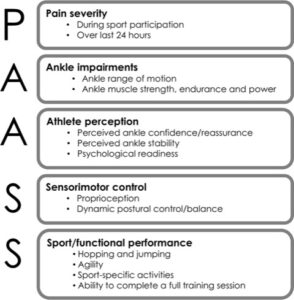This month, the British Journal of Sports Medicine released a consensus paper on making the decision to return to sport after an ankle sprain. This involved some world leading clinicians getting together and deciding what best practice might be for managing this issue based on what the research is currently telling us.
They agreed about 16 things in 5 key areas and can be summarised using the PAASS acronym:
- Pain
- Ankle impairments
- Athlete perception
- Sensorimotor control
- Sport/functional performance
Importantly, the state of the ligaments and what they looked like on a scan was not considered important in making return to sport decisions for people with this injury.
“Pain” specifically refers to rating pain experienced during sport or training participation, and how pain behaves in the subsequent 24 hours. An example of this is that you can complete a full training session or run and wake up the next day with minimal or no symptoms in your ankle. Satisfying this criterion suggests that the ankle is no longer irritable and any pain that arises settles quickly and is unlikely to impede performance.
“Ankle impairments” refer to range of motion and local muscle strength, endurance, and power. The restoration of these things is important for optimal sports performance and for recurrent injury prevention. In terms of local muscle strength, this might include:
- 25-35 single leg heel raises with your body weight
- 8-12 repetitions with 0.3-0.4 x body weight or greater in a standing single leg heel raise in a smith machine
- 1-1.5 x body weight or greater in a sitting single leg heel raise in a smith machine.
Athletes, or those with more specific sporting demands may have different targets for calf muscle function. Together with your therapist you can decide what is most important for you to achieve before returning to sport.
“Athlete perception” describes how confident an individual is in their ankle function and its ability to meet the demands of sport. This includes confidence in the stability of the ankle, and readiness to return to competition based on how their ankle feels. This might refer to feeling confident when going out on a running or participating in a training session and feeling as if you’d be ready to go if you had to play a game or a related sporting event the next day. Your therapist may get you to fill out a written questionnaire to measure this more objectively.
“Sensorimotor control” refers to how well someone can maintain their posture and balance in single leg and dynamic tasks, as well as the proprioceptive abilities of the joint (your body’s ability to sense location, movement, and position in a joint). An example of a test your therapist may use to measure sensorimotor control is the single hop test: hopping as far as you can and sticking in the landing. A certain amount of symmetry between your two legs may be important before returning to sport.
Finally, “sport and functional performance” relates to how well someone can perform the movements and tasks required for returning to sport, which may include running, jumping, and changing direction at high speeds, as well as being able to participate in drills, training sessions and sport specific activities.

Our team of physiotherapists at Complete. Physio Exercise Performance in Richmond would love to be able to help you with this. Contact today for an assessment of your ankle.


